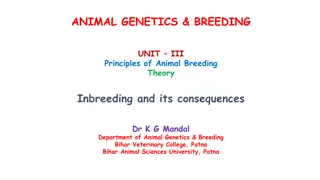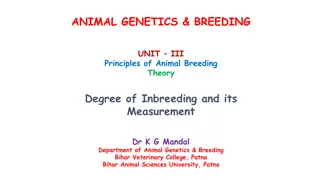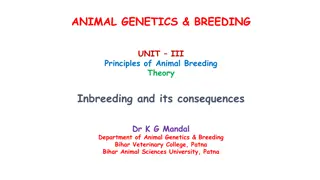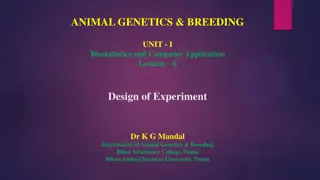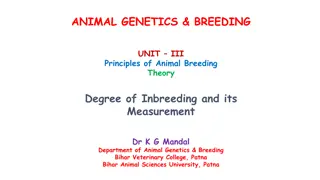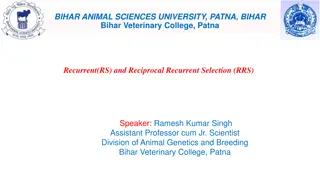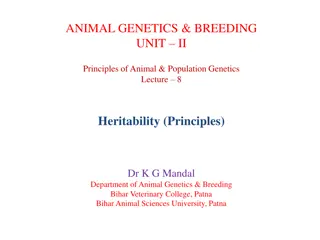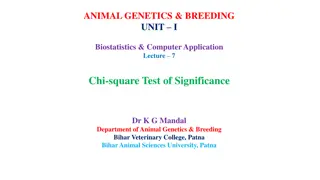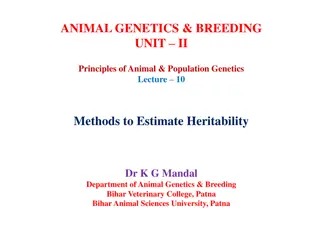Understanding Statistics in Animal Genetics and Breeding
Statistics plays a crucial role in analyzing numerical information in the field of Animal Genetics and Breeding. This article introduces the meaning of statistics, its importance, and its application in various fields. It explains how statistics help in presenting data, making logical inferences, and drawing meaningful conclusions to formulate policies and enhance decision-making. The discussion covers statistical methods such as mean, correlation, regression, and more, highlighting their significance in research and analysis.
Download Presentation

Please find below an Image/Link to download the presentation.
The content on the website is provided AS IS for your information and personal use only. It may not be sold, licensed, or shared on other websites without obtaining consent from the author. Download presentation by click this link. If you encounter any issues during the download, it is possible that the publisher has removed the file from their server.
E N D
Presentation Transcript
ANIMAL GENETICS & BREEDING UNIT I Introduction to Biostatistics Dr K G Mandal Department of Animal Genetics & Breeding Bihar Veterinary College, Patna Bihar Animal Sciences University, Patna
Meaning of Statistics: To some it is an imposing form of mathematics. To others it is the numerical forms of facts and figures commonly finds in newspapers, journals, books, various reports, Radio, etc. in the form of tables, charts & figures. Examples: There are 932 females per 1000 males in India whereas in Russia there are 1170 females per 1000 males. The per day per capita availability of milk has been increased from 100g in 1980 to 354g in 2018. The density of human population has gone up from 216 in 1981 to 315 in 2018. political speech, TV,
Numbers play an essential role in statistics. Study of statistics involve methods of refining numerical information into useful forms. Statements contain facts and figures, and as such they are called statements of facts. Numerical information are highly convenient for communication and at the same time quite clear, precise and meaningful. An analysis of statements can help in framing suitable policies by the Government.
Whenever compiled they become statistics. In other words, the term statistics is considered with ways presenting and handling of data, making inferences logically and drawing relevant conclusions. In addition to meaning data, statistics also refers to a subject just like mathematics having symbols, formulae, and theorems. In this sense statistics is a body of methods of obtaining and analyzing data. numbers are collected and and means of
Thus, the word statistics refers either to quantitative information or to a method dealing with quantitative information. Statistics may be used in plural or singular sense. Quantitative (numerical) information i.e. the statistics of birth, death, imports, exports, etc. are used in plural sense Various statistical methods like mean or average, correlation, regression, measures of dispersion, analysis of variance, etc. are used in singular sense.
The methods by which statistical data are analysed are methods. Thus, statistics collection, compilation, analysis and quantitative information. Statistical methods are applicable to a large number of fields economics, sociology, anthropology, agriculture and its allied fields such as veterinary, dairy, medicine, etc. called statistical deals with the presentation, interpretation of management,
Origin of statistics: Statistics is not a new discipline but as old as the human society itself. It has been used right from the existence of life on this earth. The word statistics has come from the Italian word statesman or German word statistik which means State. The term statistics was first used by Professor Gottfried Achenwall (1719 1772) to refer the subject matter as a whole. Achenwall defined statistics as the political science of the several countries .
The word stastistics time in the famous book, Elements of Universal Erudition by Baran J. F. Von Bielfeld and translated by W. Hooper in 1770. appeared for the first
The science of statistics is said to have originated from two main sources: Government records Mathematics (a) Government Records Since statistical data were collected for use in various purposes of the Govt., statistics was then science of king Statecraft . (b) Mathematics Statistics is said to be a branch of applied mathematics. described the as the of or science
The present form of statistical methods is based on theory of probability which marked a major step in the history of world. The gamblers of 17thcentury attracted the attention of De Moivre, Galileo and great mathematicians like James Bernoulli, Daniel Bernoulli, Laplace and Karl Gaus who discovered and developed the theory of probability while estimating the chance of wining or losing in gamble. De Moivre (1667 1754) discovered the normal curve which forms the important part of modern statistical theory. Laplace and Gaus independently arrived at the same results of De Moivre.
Great mathematician Jaques Quetlet (1796 1855) discovered the fundamental principle of the constancy of great numbers which is the basis of sampling. Sir Francis Galton (1822 1911) developed the concept of Regression. Karl Pearson (1857 1936) developed the Chi- square test of goodness of fit & Correlation. Sir Ronald A Fisher (1890 1962) made major contributions in the Designs and Analysis of Variance. Contributions of all these scientists have made significant advances in statistics. field of Experimental the development of
Statistics Defined According to Prof. Horace Secrist, means aggregate of facts affected to a marked extent by multiplicity of causes, numerically expressed, enumerated or estimated according to reasonable standards of accuracy, collected in a systematic manner for a predetermined purpose and placed in relation to each other. Characteristics of statistics (numerical data): i. Statistics are aggregates of facts. ii. Statistics are affected to a marked extent by multiplicity of causes or multiple factors. Statistics
iii. Statistics are numerically expressed. iv. Statistics are enumerated or estimated according to reasonable accuracy. v. Statistics are collected in a systemic manner. vi. Statistics are predetermined purpose. Statistics should be placed in relation to each other. Conclusion: All statistics statement of facts statements of facts are not statistics. standards of collected for a are all numerical numerical but
Statistical Methods: i. Collection ii. Compilation (a) Editing (b) Classification (c) Tabulation i. Presentation (a) Diagrams (b) Graphs iv. Analysis v. Interpretation
Definition of Biostatistics: Biostatistics is a branch of Mathematics which deals with the collection, compilation, presentation, analysis and interpretation of numerical data or quantitative information of biological organism. Statistics : Science or Art? Science is a systematised knowledge. Accordingly, statistics is regarded as a science because mathematics which principles, laws and theorem. On the other hand it is an art because it is concerned with ways and means of presenting and handling data, making inferences logically and drawing relevant conclusions. body of it deals is a with branch of various
Application of Statistics: Industry or commerce Economics Biology Botany Astronomy Physics Chemistry Education continued .
Medical science Agriculture Veterinary Dairy Sociology Meteorology, etc.
Functions of Statistics: It presents facts in a definite form. It simplifies mass of figures. It facilitates comparison. It helps in formulating and testing of hypothesis. It helps in prediction. It helps in the formulation of suitable policies.
Sl. No. Title of book Authors Publication 1. Statistical Methods Sultan Chand & Sons Dr S P Gupta 2. Statistical Methods Oxford & IBH Pub. Co. Snedecor & Cochran 3. P. N. Arora & PK Malhan Himalaya Pub. House Biostatistics 4. SK Pillai & HC Sinha Ram Prasad & Sons, Agra Statistical Methods for Biological Workers




